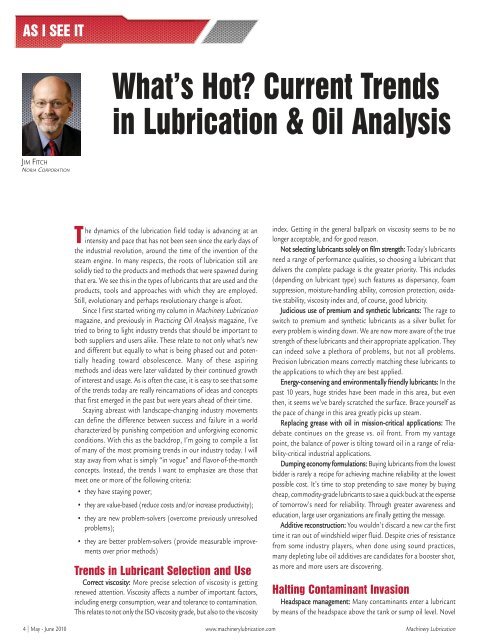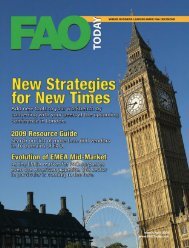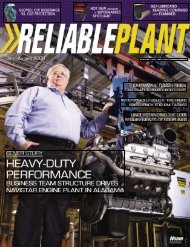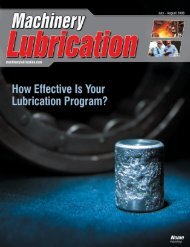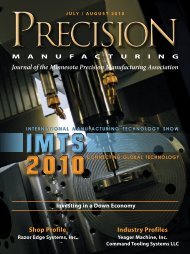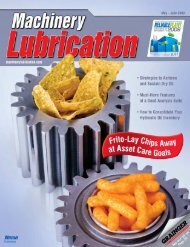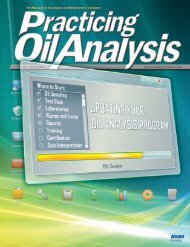Machinery Lubrication May - June 2010 - Ecn5.com
Machinery Lubrication May - June 2010 - Ecn5.com
Machinery Lubrication May - June 2010 - Ecn5.com
Create successful ePaper yourself
Turn your PDF publications into a flip-book with our unique Google optimized e-Paper software.
AS I SEE IT<br />
What’s Hot? Current Trends<br />
in <strong>Lubrication</strong> & Oil Analysis<br />
JIM FITCH<br />
NORIA CORPORATION<br />
The dynamics of the lubrication field today is advancing at an<br />
intensity and pace that has not been seen since the early days of<br />
the industrial revolution, around the time of the invention of the<br />
steam engine. In many respects, the roots of lubrication still are<br />
solidly tied to the products and methods that were spawned during<br />
that era. We see this in the types of lubricants that are used and the<br />
products, tools and approaches with which they are employed.<br />
Still, evolutionary and perhaps revolutionary change is afoot.<br />
Since I first started writing my column in <strong>Machinery</strong> <strong>Lubrication</strong><br />
magazine, and previously in Practicing Oil Analysis magazine, I’ve<br />
tried to bring to light industry trends that should be important to<br />
both suppliers and users alike. These relate to not only what’s new<br />
and different but equally to what is being phased out and potentially<br />
heading toward obsolescence. Many of these aspiring<br />
methods and ideas were later validated by their continued growth<br />
of interest and usage. As is often the case, it is easy to see that some<br />
of the trends today are really reincarnations of ideas and concepts<br />
that first emerged in the past but were years ahead of their time.<br />
Staying abreast with landscape-changing industry movements<br />
can define the difference between success and failure in a world<br />
characterized by punishing competition and unforgiving economic<br />
conditions. With this as the backdrop, I’m going to compile a list<br />
of many of the most promising trends in our industry today. I will<br />
stay away from what is simply “in vogue” and flavor-of-the-month<br />
concepts. Instead, the trends I want to emphasize are those that<br />
meet one or more of the following criteria:<br />
• they have staying power;<br />
• they are value-based (reduce costs and/or increase productivity);<br />
• they are new problem-solvers (overcome previously unresolved<br />
problems);<br />
• they are better problem-solvers (provide measurable improvements<br />
over prior methods)<br />
Trends in Lubricant Selection and Use<br />
Correct viscosity: More precise selection of viscosity is getting<br />
renewed attention. Viscosity affects a number of important factors,<br />
including energy consumption, wear and tolerance to contamination.<br />
This relates to not only the ISO viscosity grade, but also to the viscosity<br />
index. Getting in the general ballpark on viscosity seems to be no<br />
longer acceptable, and for good reason.<br />
Not selecting lubricants solely on film strength: Today’s lubricants<br />
need a range of performance qualities, so choosing a lubricant that<br />
delivers the complete package is the greater priority. This includes<br />
(depending on lubricant type) such features as dispersancy, foam<br />
suppression, moisture-handling ability, corrosion protection, oxidative<br />
stability, viscosity index and, of course, good lubricity.<br />
Judicious use of premium and synthetic lubricants: The rage to<br />
switch to premium and synthetic lubricants as a silver bullet for<br />
every problem is winding down. We are now more aware of the true<br />
strength of these lubricants and their appropriate application. They<br />
can indeed solve a plethora of problems, but not all problems.<br />
Precision lubrication means correctly matching these lubricants to<br />
the applications to which they are best applied.<br />
Energy-conserving and environmentally friendly lubricants: In the<br />
past 10 years, huge strides have been made in this area, but even<br />
then, it seems we’ve barely scratched the surface. Brace yourself as<br />
the pace of change in this area greatly picks up steam.<br />
Replacing grease with oil in mission-critical applications: The<br />
debate continues on the grease vs. oil front. From my vantage<br />
point, the balance of power is tilting toward oil in a range of reliability-critical<br />
industrial applications.<br />
Dumping economy formulations: Buying lubricants from the lowest<br />
bidder is rarely a recipe for achieving machine reliability at the lowest<br />
possible cost. It’s time to stop pretending to save money by buying<br />
cheap, commodity-grade lubricants to save a quick buck at the expense<br />
of tomorrow’s need for reliability. Through greater awareness and<br />
education, large user organizations are finally getting the message.<br />
Additive reconstruction: You wouldn’t discard a new car the first<br />
time it ran out of windshield wiper fluid. Despite cries of resistance<br />
from some industry players, when done using sound practices,<br />
many depleting lube oil additives are candidates for a booster shot,<br />
as more and more users are discovering.<br />
Halting Contaminant Invasion<br />
Headspace management: Many contaminants enter a lubricant<br />
by means of the headspace above the tank or sump oil level. Novel<br />
4 <strong>May</strong> - <strong>June</strong> <strong>2010</strong> www.machinerylubrication.com <strong>Machinery</strong> <strong>Lubrication</strong>


